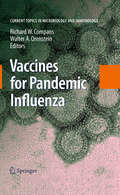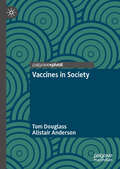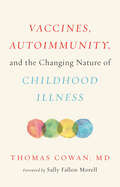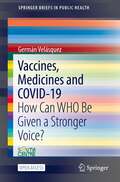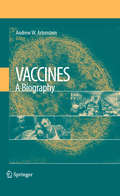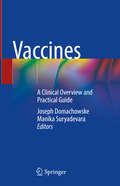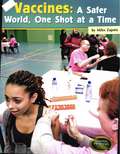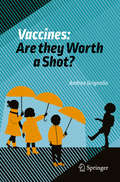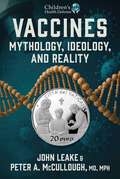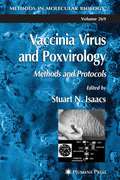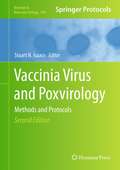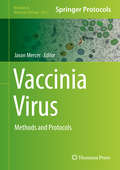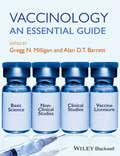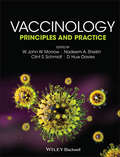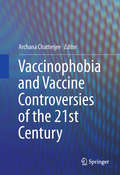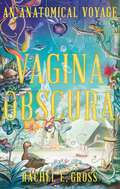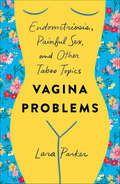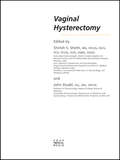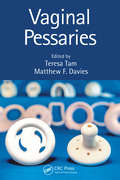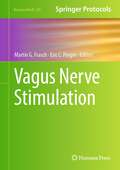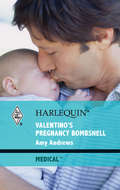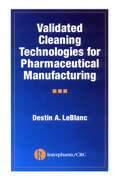- Table View
- List View
Vaccines for Pandemic Influenza
by Richard W Compans Walter A. OrensteinThe recent outbreak of disease caused by a novel H1N1 virus has focused global attention on the threat of a new influenza pandemic. Recent years have also seen unprecedented outbreaks of avian influenza A viruses. In particular, highly pathogenic H5N1 viruses have not only resulted in widespread outbreaks in domestic poultry, but have been transmitted to humans resulting in numerous fatalities. The rapid expansion in the geographic distribution of these novel viruses raises the risk that such a virus could cause a global pandemic with high morbidity and mortality. An effective influenza vaccine represents the best approach to prevent and control such an emerging pandemic. However, current influenza vaccines are directed at existing seasonal influenza viruses, which have limited antigenic relationships to the newly emerging virus strains. Concerns about pandemic preparedness have greatly stimulated research activities to develop effective vaccines for pandemic influenza viruses, and to overcome the limitations inherent in current approaches to vaccine production and distribution. These limitations include the use of embryonated chicken eggs as the substrate for vaccine production; which is time-consuming and could involve potential biohazards in growth of new virus strains. Other limitations... more on http://springer.com/978-3-540-92164-6
Vaccines for the 21st Century: A Tool for Decisionmaking
by Institute of MedicineVaccines have made it possible to eradicate the scourge of smallpox, promise the same for polio, and have profoundly reduced the threat posed by other diseases such as whooping cough, measles, and meningitis. What is next? There are many pathogens, autoimmune diseases, and cancers that may be promising targets for vaccine research and development. This volume provides an analytic framework and quantitative model for evaluating disease conditions that can be applied by those setting priorities for vaccine development over the coming decades. The committee describes an approach for comparing potential new vaccines based on their impact on morbidity and mortality and on the costs of both health care and vaccine development. The book examines: Lessons to be learned from the polio experience. Scientific advances that set the stage for new vaccines. Factors that affect how vaccines are used in the population. Value judgments and ethical questions raised by comparison of health needs and benefits. The committee provides a way to compare different forms of illness and set vaccine priorities without assigning a monetary value to lives. Their recommendations will be important to anyone involved in science policy and public health planning: policymakers, regulators, health care providers, vaccine manufacturers, and researchers.
Vaccines in Society
by Tom Douglass Alistair AndersonThis book argues that the social story of vaccination has commonly been told through the lens of vaccine hesitancy and the myriad challenges that this broad issue poses for public health and the mitigation of preventable harms. Consequently, less sustained analytical attention has been given by social scientists to the rich tapestry of other social and political dimensions of vaccines and consequences of vaccination. This book begins from the premise that a broader approach to the technology and intervention of vaccination is required and that further social scientific analysis is needed of how societies produce and preserve high levels of vaccination coverage, as well as the social and political challenges or threats – beyond vaccine hesitancy – that may harm or restrict it. To achieve this, the book assembles and reframes evidence from medical sociology, science and technology studies, public health, health geography, and the medical humanities. In doing so it looks across the ‘immunisation social order’ by analysing dimensions that have thus far been neglected or under-scrutinised, revealing not only the functioning of and central challenges to the immunisation social order, but also bringing into sharp focus the social and political nature of vaccines themselves.
Vaccines, Autoimmunity, and the Changing Nature of Childhood Illness
by Thomas CowanOne doctor&’s surprising answer to the epidemic of chronic disease and essential reading for everyone concerned with the health of the next generation&“Dr. Cowan intelligently educates us on the complicated and beautiful workings of our immune system [and] charts the clear, concise path to healing, offering a better, healthier life for us, our children, and the planet.&”—Lindy Woodard, MD, Pediatric AlternativesOver the past fifty years, rates of autoimmunity and chronic disease have exploded. Currently:1 in 2.5 American children has an allergy1 in 11 has asthma1 in 13 has severe food allergies1 in 36 has autism.While some attribute this rise to increased awareness and diagnosis, Thomas Cowan, MD, argues for a direct causal relationship to a corresponding increase in the number of vaccines American children typically receive—approximately 70 vaccine doses by age eighteen. The goal of these vaccines is precisely what we&’re now seeing in such abundance among our chronically ill children: the provocation of immune response.Dr. Cowan looks at emerging evidence that certain childhood illnesses are actually protective of disease later in life; examines the role of fever, the gut, and cellular fluid in immune health; argues that vaccination is an ineffective (and harmful) attempt to shortcut a complex immune response; and asserts that the medical establishment has engaged in an authoritarian argument that robs parents of informed consent. His ultimate question, from the point of view of a doctor who has decades of experience treating countless children is: What are we really doing to children when we vaccinate them?
Vaccines, Medicines and COVID-19: How Can WHO Be Given a Stronger Voice? (SpringerBriefs in Public Health)
by Germán VelásquezThis open access book is a collection of research papers on COVID-19 by Germán Velásquez from 2020 and early 2021 that help to answer the question: How can an agency like the World Health Organization (WHO) be given a stronger voice to exercise authority and leadership? The considerable health, economic and social challenges that the world faced at the beginning of 2020 with COVID-19 continued and worsened in many parts of the world in the second-half of 2020 and into 2021. Many of these countries and nations wanted to explore COVID-19 on their own, sometimes without listening to the main international health bodies such as WHO, an agency of the United Nations system with long-standing experience and vast knowledge at the global level and of which all countries in the world are members. In this single volume, the chapters present the progress of thinking and debate — particularly in relation to drugs and vaccines — that would enable a response to the COVID-19 pandemic or to subsequent crises that may arise. Among the topics covered:COVID-19 Vaccines: Between Ethics, Health and EconomicsMedicines and Intellectual Property: 10 Years of the WHO Global StrategyRe-thinking Global and Local Manufacturing of Medical Products After COVID-19Rethinking R&D for Pharmaceutical Products After the Novel Coronavirus COVID-19 ShockIntellectual Property and Access to Medicines and VaccinesThe World Health Organization Reforms in the Time of COVID-19Vaccines, Medicines and COVID-19: How Can WHO Be Given a Stronger Voice? is essential reading for negotiators from the 194 member countries of the World Health Organization (WHO); World Trade Organization (WTO) and World Intellectual Property Organization (WIPO) staff participating in these negotiations; academics and students of public health, medicine, health sciences, law, sociology and political science; and intergovernmental organizations and non-governmental organizations that follow the issue of access to treatments and vaccines for COVID-19.
Vaccines: A Biography
by Andrew W. ArtensteinThe History and Biography of Vaccines against Infectious Diseases is a multi-authored book, written for an academic audience but accessible to a general readership as well. The book examines the human stories that underlie the development of vaccines against infectious diseases. Each chapter traces the lineage of a vaccine by examining the people behind the scientific hypotheses and discoveries that led to vaccine breakthroughs. These stories are firmly anchored in their historical context, as the "biography" of a vaccine generally has its origins in a medical problem rooted within a social context that subsequently engages scientists and enlists others in the eventual solution. A prominent theme woven throughout the book is the interdependence of incremental scientific advances and investigators on one another and how such advances ultimately led to practical, preventive solutions to major public health problems in society. Additionally, the human aspect of various pivotal events in the histories of specific vaccines are illustrated--this includes scientific and political hurdles and details of clinical trial controversies. In this fashion the work interweaves scientific themes, personal stories of those involved, and the sociohistorical context in which they worked in a manner that illustrates their inter-relatedness and provides the reader with exciting accounts of these advances.
Vaccines: A Clinical Overview and Practical Guide
by Joseph Domachowske Manika SuryadevaraThis book is designed to provide easy-to-read and basic information about vaccines for those undertaking a vaccine course or for medical providers seeking to improve their skills. Written by expert medical educators in the areas of infectious diseases, medical microbiology, and pediatrics, this book begins by establishing the fundamentals of vaccines such as what constitutes a vaccine, how they are manufactured and composed, how they are tested for safety and efficacy, and how vaccine recommendations are developed and conveyed to health care providers and their patients. The book then explains the composition, safety profile, effectiveness, and current recommendations for use of every available vaccine, alphabetized by infection. The concluding section illuminates practical concerns every vaccinating clinician experiences, including vaccine confidence and hesitancy, misconceptions, and patient communication. Vaccines: A Clinical Overview and Practical Guide is an excellent learning tool for all students and providers administering vaccines to patients, including infectious disease specialists and other internal medicine subspecialists, pediatricians, geriatricians, as well as all other primary care physicians, nurse practitioners, physician’s assistants, and nurses.
Vaccines: A Safer World, One Shot at a Time (Fountas & Pinnell LLI Purple #Level W)
by Miles ZapataVaccines: A Safer World, One Shot at a Time by Miles Zapata *** SOLVING PROBLEMS SERIES
Vaccines: Are they Worth a Shot?
by Andrea Grignolio Joan RundoThe dangerous decline in vaccinations in many developed countries is at the heart of a lively debate that confirms how important the subject is today. Vaccinations are among mankind’s most important scientific discoveries, yet they continue to be viewed with suspicion by part of the public – the victims of disinformation campaigns, instrumentalization and unfounded fears. There is, however, also an evolutionary explanation for these irrational beliefs, and countering the growing social opposition will be extremely difficult without grasping it. This book, which sheds new light on the safety and importance of vaccinations, is intended both for parents and those readers who want to understand the role of vaccinations in contemporary society, where the ease of access to knowledge is both a great opportunity and a great responsibility. The chapters follow a historical progression and conclude with a discussion of the most recent cognitive theories on how to overcome this opposition to vaccinations.
Vaccines: Mythology, Ideology, and Reality
by John Leake Peter A. McCulloughThe word &“vaccine&” derives from the Latin word for cow. The English physician, Edward Jenner, coined it in his 1798 pamphlet An Inquiry into the Causes and Effects of the Variolae Vaccinae. The last two Latin words mean &“Smallpox of the Cow,&” or cowpox. Jenner postulated that cowpox causes mild disease in humans while protecting them from the more dangerous smallpox. His proposal for inoculation with a weak form of disease-causing matter to prevent serious illness became the central concept of infectious disease medicine and has remained so ever since. The word &“vaccine&” was subsequently applied to immunizations against all infectious diseases. Its etymology is amazingly apt, because vaccines are the ultimate sacred cow. Vaccines: Mythology, Ideology, and Reality tells the story of this technology and the celebrated men who developed it with some success, but also with failures that are never mentioned in the celebratory literature on vaccines. Vaccine advocates often proclaim that they &“follow the science,&” but most vaccine development has been a matter of guesses, gambles, and wild experimentation. Its key figures have been biased by religious faith, wishful thinking, ideology, and a desire for recognition and money. Though credit is due to some vaccines for reducing infectious disease morbidity and mortality, their contribution to public health in developed nations has been grossly exaggerated by propagandists. Dramatic improvements in nutrition and sanitation were the primary drivers of this trend. The authors do not dismiss the concept of vaccination but seek to promote a more informed and less dogmatic discussion about its risks and benefits. Critical evaluation can only make the technology safer and more effective.
Vaccinia Virus and Poxvirology
by Stuart N. IsaacsA comprehensive collection of cutting-edge methods to study and work with the vaccinia virus and other poxvirus gene transcriptions. These readily reproducible techniques can be used for the construction and characterization of recombinant viruses; for the study of poxvirus gene transcription and DNA replication; for the investigation of the binding, entry, and movement of the virus in host cells; and for the use of the virus in immunologic and cell-cell fusion assays. Other methods cover poxvirus bioinformatics, aspects of viral pathogenesis at both a protein and an animal model level, and the study of immune responses to poxviruses-the latter a critical ability given the important role of vaccinia virus in smallpox vaccination and their potential role as vaccine vectors directed against infectious agents and cancer.
Vaccinia Virus and Poxvirology, 2nd Edition
by Stuart N. IsaacsSince the first edition of Vaccinia Virus and Poxvirology: Methods and Protocols was published, a number of important events related to poxvirology have occurred, such as FDA approval of a culture-based live smallpox vaccine and the vaccination of large numbers of U.S. military and relatively large numbers of U.S. civilians. Novel anti-poxvirus therapeutics have been developed and have been used in emergency settings. The second edition of Vaccinia Virus and Poxvirology expands upon the previous edition with entirely new sets of protocols. Written in the highly successful Methods in Molecular Biology™ series format, chapters include introductions to their respective topics, lists of the necessary materials and reagents, step-by-step, readily reproducible laboratory protocols, and key tips on troubleshooting and avoiding known pitfalls.<P><P> Authoritative and practical, Vaccinia Virus and Poxvirology: Methods and Protocols, Second Edition seeks to aid scientists in continuing to study poxviruses using new tools and approaches.
Vaccinia Virus: Methods and Protocols (Methods in Molecular Biology #2023)
by Jason MercerThis detailed book provides practical information for the laboratory that can be applied to the study of vaccinia and other poxviruses while emphasizing long-standing field standards and focusing on emerging new technologies applied in the field of poxvirology. The methods and protocols have been designed with the bench scientist in mind, being presented in a fashion that makes them useful for both starting and veteran poxvirus researchers. Written for the highly successful Methods in Molecular Biology series, chapters include introductions to their respective topics, lists of the necessary materials and reagents, step-by-step, readily reproducible laboratory protocols, and tips on troubleshooting and avoiding known pitfalls. Authoritative and cutting-edge, Vaccinia Virus: Methods and Protocols serves as a valuable resource for scientists looking to bring new methods and procedures into their lab in order to make exciting discoveries that will continue to deepen our understanding of this fascinating virus family.
Vaccinology
by Gregg N. Milligan Alan D. BarrettVaccinology: An Essential Guide outlines in a clear, practical format the entire vaccine development process, from conceptualization and basic immunological principles through to clinical testing and licensing of vaccines. With an outstanding introduction to the history and practice of vaccinology, it also guides the reader through the basic science relating to host immune responses to pathogens.Covering the safety, regulatory, ethical, and economic and geographical issues that drive vaccine development and trials, it also presents vaccine delivery strategies, novel vaccine platforms (including experimental vaccines and pathogens), antigen development and selection, vaccine modelling, and the development of vaccines against emerging pathogens and agents of bioterror. There are also sections devoted to veterinary vaccines and associated regulatory processes.Vaccinology: An Essential Guide is a perfect tool for designed for undergraduate and graduate microbiologists and immunologists, as well as residents, fellows and trainees of infectious disease and vaccinology. It is also suitable for all those involved in designing and conducting clinical vaccine trials, and is the ideal companion to the larger reference book Vaccinology: Principles and Practice.
Vaccinology
by Clint S. Schmidt W. John Morrow D. Huw Davies Nadeem A. SheikhCovering all aspects of vaccine research and development in one volume, this authoritative resource takes a comprehensive and systematic approach to the science of vaccinology focusing not only on basic science, but also on the many stages required to commercialize and navigate the regulatory requirements for human application, both in the United States and Europe.Reviews in detail the process of designing a vaccine, from the initial stages of antigen discovery to human applicationIncludes evaluation of vaccine efficacy and safetyDetails clinical trial design, including regulatory requirementsDiscusses the emerging field of active cellular immunotherapyVaccinology: Principles and Practice provides an invaluable resource for clinicians, scientific and medical researchers, lecturers and postdoctoral fellows working in the field of vaccines.
Vaccinophobia and Vaccine Controversies of the 21st Century
by Archana ChatterjeeVaccinophobia and Vaccine Controversies of the 21st Century Archana Chatterjee, editor Once hailed as a medical miracle, vaccination has come under attack from multiple fronts, including occasionally from within medicine. And while the rates of adverse reactions remain low, suggestions that vaccines can cause serious illness (and even death) are inspiring parents to refuse routine immunizations for their children--ironically, exposing them and others to potentially serious illness. Vaccinophobia and Vaccine Controversies of the 21st Century explains clearly how this state of affairs came into being, why it persists, and how healthcare professionals can best respond. Current findings review answers to bedrock questions about known adverse events, what vaccine additives are used for, and real and perceived risks involved in immunization. Perspectives representing pediatricians, family practitioners, nurses, parents, pharmacy professionals, the CDC, and the public health community help the reader sort out legitimate from irrational concerns. In-depth analyses discuss the possibility of links with asthma, cancer, Guillain-Barre syndrome, SIDS, and, of course, autism. Included in the coverage: Communicating vaccine risks and benefitsThe vaccine misinformation landscape in family medicinePerceived risks from live viral vaccinesThe media's role in vaccine misinformationAutoimmunity, allergies, asthma, and a relationship to vaccinesVaccines and autism: the controversy that won't go awayThe conundrums described here are pertinent to practitioners in pediatrics, family medicine, primary care, and nursing to help families with informed decision making. In addition, Vaccinophobia and Vaccine Controversies of the 21st Century should be read by trainees and researchers in child development and maternal and child health as the book's issues will have an impact on future generations of children and their families.
Vagina Obscura: An Anatomical Voyage
by Rachel E. GrossA myth-busting voyage into the female body. A camera obscura reflects the world back but dimmer and inverted. Similarly, science has long viewed woman through a warped lens, one focused narrowly on her capacity for reproduction. As a result, there exists a vast knowledge gap when it comes to what we know about half of the bodies on the planet. That is finally changing. Today, a new generation of researchers is turning its gaze to the organs traditionally bound up in baby-making—the uterus, ovaries, and vagina—and illuminating them as part of a dynamic, resilient, and ever-changing whole. Welcome to Vagina Obscura, an odyssey into a woman’s body from a fresh perspective, ushering in a whole new cast of characters. In Boston, a pair of biologists are growing artificial ovaries to counter the cascading health effects of menopause. In Melbourne, a urologist remaps the clitoris to fill in crucial gaps in female sexual anatomy. Given unparalleled access to labs and the latest research, journalist Rachel E. Gross takes readers on a scientific journey to the center of a wonderous world where the uterus regrows itself, ovaries pump out fresh eggs, and the clitoris pulses beneath the surface like a shimmering pyramid of nerves. This paradigm shift is made possible by the growing understanding that sex and gender are not binary; we all share the same universal body plan and origin in the womb. That’s why insights into the vaginal microbiome, ovarian stem cells, and the biology of menstruation don’t mean only a better understanding of female bodies, but a better understanding of male, non-binary, transgender, and intersex bodies—in other words, all bodies. By turns funny, lyrical, incisive, and shocking, Vagina Obscura is a powerful testament to how the landscape of human knowledge can be rewritten to better serve everyone.
Vagina Problems: Endometriosis, Painful Sex, and Other Taboo Topics
by Lara Parker“In Vagina Problems…Lara Parker unpacks the personal and economic costs of endometriosis.” —Vanity Fair“A refreshingly honest read about living with chronic pain.” —Hello GigglesWith unflinching honesty, Lara Parker, the Deputy Director for BuzzFeed, shares her day-to-day challenges of living, working, and loving with chronic pain caused by endometriosis in this raw, darkly humorous, and hopeful memoir.I wasn’t ready to be completely honest about my vagina yet, and the world wasn’t ready for that either. But I was getting there. I wanted the world to know that all of this pain I had been feeling…that it was related to my vagina. Thus, Vagina Problems was born. It was a cutesy name. It was my way of taking this pain and saying, “Whatever. I’m here. I have it. It sucks. Let’s talk about it.”In April 2014, Deputy Editorial Director at BuzzFeed Lara Parker opened up to the world in an article on the website: she suffers from endometriosis. And beyond that? She let the whole world know that she wasn’t having any sex, as sex was excruciatingly painful. Less than a year before, she received not only the diagnosis of endometriosis, but also a diagnosis of pelvic floor dysfunction, vulvodynia, vaginismus, and vulvar vestibulitis. Combined, these debilitating conditions have wreaked havoc on her life, causing excruciating pain throughout her body since she was fourteen years old. These are her Vagina Problems. It was five years before Lara learned what was happening to her body. Five years of doctors insisting she just had “bad period cramps,” or implying her pain was psychological. Shamed and stigmatized, Lara fought back against a medical community biased against women and discovered that the ignorance of many doctors about women’s anatomy was damaging more than just her own life. One in ten women have endometriosis and it takes an average of seven years before they receive an accurate diagnosis—or any relief from this incurable illness’ chronic pain. With candid revelations about her vaginal physical therapy, dating as a straight woman without penetrative sex, coping with painful seizures while at the office, diet and wardrobe malfunctions when your vagina hurts all the time, and the depression and anxiety of feeling unloved, Lara tackles it all in Vagina Problems: Endometriosis, Painful Sex, and Other Taboo Topics with courage, wit, love, and a determination to live her best life.
Vaginal Hysterectomy
by Frcog Facs DSc Shirish S. Sheth Fics Ficog Fcps Fams Fsogc John StuddIn recent years advances in laparoscopic technologies have led to renewed interest in the vaginal approach to hysterectomy, which has many proven benefits for patients. This volume, dedicated to explaining and promoting the vaginal route of hysterectomy, is written and edited by an international team of experts and provides a much-needed source of
Vaginal Pessaries
by Teresa Tam Matthew F. DaviesWith mesh surgery for prolapse sometimes proving problematic, there has been a resurgence of professional medical interest in more traditional methods for the management of prolapse and of stress urinary incontinence. This concise guide to the practical aspects of pessary use will be of interest to all gynecologists involved in the clinical management of the patient with these problems. Contents: Historical review * Pessaries for pelvic organ prolapse * Incontinence pessaries * Pessary fitting * Pessary care * Outcomes of pessary use * Current clinical studies on vaginal pessaries Cover image of vaginal pessaries © 2019 Rick Hicaro, Jr., Chicago, IL 60647, USA
Vagus Nerve Stimulation
by James Robertson Claude Roux Kenneth G. WigginsThis second edition presents a timely and practical discussion of vagal nerve stimulation in a clear and well-illustrated format. It provides a clinical approach to the treatment of patients with medically-intractable seizures, as well as for those with depression (a new indication since the publication of first edition). The book's focus has made
Vagus Nerve Stimulation (Neuromethods #205)
by Martin G. Frasch Eric C. PorgesThis volume covers the latest research and development in the areas of Vagus Nerve Stimulation (VNS) as it relates to bioelectronic medicine from neonate to adult. The chapters in this book cover topics such as invasive and non-invasive VNS including methodological considerations (study design, stimulation parameters, and use of heart rate variability metrics); mechanisms of action (automatic regulation and immune plasticity); and disorders where VNS approaches may be therapeutic (migraine and cluster headaches, mood disorders, trauma-related disorders, and language learning). In the Neuromethods series style, chapters include the kind of detail and key advice from the specialists needed to get successful results in your laboratory.Comprehensive and thorough, Vagus Nerve Stimulation is a valuable resource for both novice and expert preclinical and clinical scientists, clinicians, physicians, and scholars who are interested in learning more about this exciting and developing field.
Vakbekwaam indiceren: Een handreiking voor wijkverpleegkundigen
by Henk Rosendal José van DorstDit boek helpt bij het indiceren van ‘verpleging en verzorging zonder verblijf’. Het 7-stappenmodel zorgt ervoor dat er onderbouwd en transparant geïndiceerd wordt. Deze handreiking is bedoeld voor wijkverpleegkundigen en studenten verpleegkunde.Deze geheel herziene versie van Vakbekwaam Indiceren is overzichtelijker doordat stappen uit het 11-stappenmodel zijn samengevoegd. Het nieuwe 7-stappenmodel is ook in lijn met het verpleegkundig proces, de basis van verpleegkundig handelen. Hoewel in deze handreiking in eerste instantie is uitgegaan van Nanda-I, Noc en Nic, wordt per stap ook aangegeven hoe gebruikers van het Omaha-systeem hiermee om kunnen gaan.Aan de hand van het verpleegkundig proces worden de volgende stappen besproken: anamnese/assessment, verpleegkundige diagnoses, bepalen zorgresultaten, indiceren, organiseren/uitvoeren, monitoren/evalueren en borgen kwaliteit. Dit is de meest logische en meest gebruikte volgorde. Toch moet het in de praktijk wel eens anders. Daarom sluit het boek af met een hoofdstuk over een alternatieve werkwijze.Vakbekwaam Indiceren is geschreven door Henk Rosendal, lector De Gezonde Wijk bij Kenniscentrum Zorginnovatie van Hogeschool Rotterdam en José van Dorst, vakinhoudelijk manager bij TWB Thuiszorg met Aandacht.
Valentino's Pregnancy Bombshell
by Amy AndrewsOne danceWhen Paige buttons up her silk bridesmaid dress she feels beautiful for the first time in years-giving her the courage to take deliciously dangerous Valentino Lombardi's hand on the dance floor.One kissPaige spends one incredible night with Valentino. Until the cold light of dawn reminds her she's a single mom with a daughter who really needs her care. As the sun rises she creeps away.One baby!Then Valentino arrives as the new surgeon at her hospital, with his playboy reputation in tow! But the bombshells don't stop there-now Paige must tell Valentino she's expecting his baby....
Validated Cleaning Technologies for Pharmaceutical Manufacturing
by Destin A. LeBlancWritten by an expert for those who must design validatable cleaning processes and then validate those processes, this book discusses interdependent topics from various technical areas and disciplines. It shows how each piece of the cleaning process fits into the validation program, making it more defensible in both internal quality audits and exter
